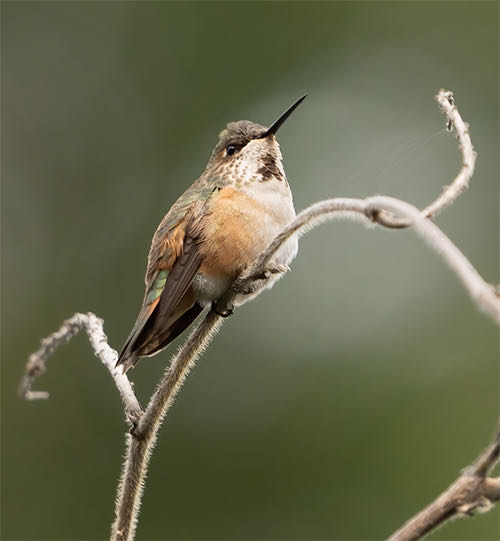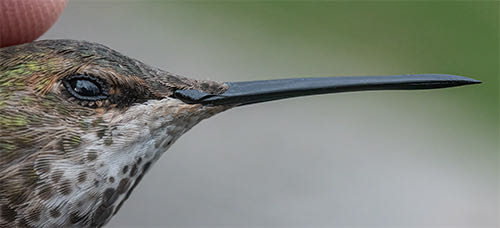- Established 1982 -HOME: www.hiltonpond.org
THIS WEEK at HILTON POND Subscribe for free to our award-winning nature newsletter (Back to Preceding Week; on to Next Week) |
(immature male Rufous Hummingbird at right) |
RUFOUS HUMMINGBIRD BANDED Ruby-throated Hummingbirds are the only breeding hummers in the Carolina Piedmont, so that's the species we typically see at Hilton Pond Center from late March through mid-October. The Trochilid Family is much larger out west, where Arizona hosts at least 11 nesting hummingbirds and California six. After our ruby-throats have departed for the Neotropics some of those western breeders occasionally wander this way--we call them vagrants--and show up in winter backyards east of the Mississippi. Such was the case this week on 13 December when a winter vagrant hummingbird was observed visiting a feeder at the home of Drs. Susan and John Demchak near the banks of Lake Wylie in Rock Hill SC.
All text, maps, charts & photos © Hilton Pond Center Knowing our interest in winter vagrant hummingbirds, John--who recently became involved in birding--contacted us at Hilton Pond Center and invited us to visit and band the hummer to confirm it was NOT a Ruby-throated Hummingbird. As soon as the bird was coming regularly to a back porch feeder we arranged a date for a banding session. This happened to be 17 December--the day of the York/Rock Hill SC Christmas Bird Count--so we'd benefit doubly by getting a winter hummer banded AND positively identifying it for the count tally.
All text, maps, charts & photos © Hilton Pond Center To be honest, John's in situ images (above and below)--taken through the glass with long telephoto lens--were so good we were 98% sure his hummer was an adult female Rufous Hummingbird, Selasphorus rufus. The photos showed nearly every characteristics needed to age the bird and identify it to species. Just to be sure, however, having the bird in hand to make measurements would rule out the closely-related and very similar Allen's Hummingbird, S. sasin. Getting the Demchak hummer banded also offered the possibility of tracking its migration if it is encountered next spring within its breeding range out west. And there's always the chance this wandering bird will show up at the Demchak feeder next year when we can recapture it and confirm its return.
All text, maps, charts & photos © Hilton Pond Center Trapping this hummingbird turned out to be an interesting experience. When we visit homeowners hosting winter hummers, we take along a trap made of wire mesh and outfitted with a sliding door triggered by a remote transmitter. When we arrived at the Demchak residence John helped us move the existing feeder into the trap and set everything up in exactly the same place. We waited inside the house for a hummer to enter the trap to dine from the now-enclosed feeder--at which point we would flick a switch on the transmitter and a motor on the trap would turn, releasing the door that would slide shut to capture the bird. Even with naked eye ee could see the Demchak hummer perched and flitting about in in a nearby shrub. When within five minutes it was investigating our device, trying to figure out how to get at the feeder. At seven-minute mark it entered the trap and we flipped the switch--but nothing happened! The motor didn't engage and the door didn't shut! Even with the door open, however, the trap is designed so it's hard for a hummingbird to exit on its own, so we simply walked up to the trap, reached in, cornered the hummer, and had it in hand. So much for high-tech hummingbird trapping! (On-line research suggests our radio-controlled system was somehow interfered with by electronic signals in the Demchak home--perhaps a security system or wi-fi router.)
All text, maps, charts & photos © Hilton Pond Center Up close it was easy to see the Demchak hummingbird had a central cluster of iridescent gorget feathers (above) that were bronzy-red rather than ruby-red, with smaller randomly placed greenish feathers. This is typical of adult female Rufous Hummingbirds; adult males have a full gorget, young males usually have metallic red feathers (if any) scattered randomly, while young females sometimes lack metallic gorget feathers altogether. (Female Ruby-throated Hummingbirds almost always show a completely white throat, and before migrating south young males bear zero to several red feathers in varying patterns.)
All text, maps, charts & photos © Hilton Pond Center In dorsal view (above) the hummer looked for all the world like an adult female Ruby-throated Hummingbird with a uniform green back and white outer tail feathers. (Unlike the adult above, young hummingbirds often have visible pale brown edging to their back feathers, giving a slight scalloping appearance. Also, adult male Rufous Hummingbirds show a rusty back while adult male Allen's Hummingbirds are green-backed, sometimes with a few rusty back feathers and showing a rusty rump.)
All text, maps, charts & photos © Hilton Pond Center In ventral view (above) the Demchak hummer was definitely not a ruby-throat because of prominent rusty flanks, rusty undertail coverts, and some rust visible in the tail. That central iridescent spot on the gorget is also apparent.
All text, maps, charts & photos © Hilton Pond Center Hummingbirds have ten rectrices (tail feathers)--five on each side--numbered (above) from the outside in. Numbers 5, 4,and 3 have white tips and rusty bases, while 2 and 1 are mostly green and black. Numbers 5 and 2 are of particular interest, because in Allen's Hummingbird the fifth rectrix is very much narrower than what shows in the Rufous Hummingbird tail above. Note also that rectrix #2 has noticeable dimpling--sure sign of a female Rufous. (Rusty tail bases likewise rule out Ruby-throated Hummingbird in which feather bases are greenish-black. ) We should mention that other Selasphorus hummingbirds occasionally appear in the eastern U.S. and also have rusty-based rectrices. These include Broad-tailed Hummingbird, S. platycerus--which is a bit larger than a Rufous--and the more petite Calliope Hummingbird, S. calliope.
All text, maps, charts & photos © Hilton Pond Center Ageing hummingbirds is easy when the individual is young. In the nest and prior to fledging a baby hummingbird's bill grows so fast it lays down barely macroscopic etchings or "corrugations" that, over time, smooth out from the bill tip to base. Thus, a hummer with a totally smooth bill is older, while those with full or partial corrugations closer to the base are young. By December of a hummingbird's hatch year much of that smoothing may already have occurred, but with a hand lens we determined the Demchak bird had no etchings at all, further suggesting it was an adult. (The corrugations are indeed hard to see, but we assure you there are none in the photo above.)
All text, maps, charts & photos © Hilton Pond Center A full set of measurements confirmed the Demchak bird was indeed a female Rufous Hummingbird. As in most trochilid species, females are larger than males by every measure, and this bird had a mass of 3.7g and wing chord, tail, and exposed culmen (bill length) measures at the upper end of those expected for a female Rufous. They were also larger than would be found in female Allen's Hummingbirds. With all that knowledge in hand, as is our protocol we banded the Demchak hummer on her right leg with band #H81118 (above), went outside, and handed the bird to John Demchak (below). He accepted the hummer with the steady hand of a physician and examined it closely before releasing it unharmed.
All text, maps, charts & photos © Hilton Pond Center We thank the Demchaks for allowing us to capture and band the adult female Rufous Hummingbird they were hosting. (John reports their bird returned to regular feeding behavior soon after its banding experience.) Having begun 'way back in 1991 (see Vagrant Hummingbirds), our study of wintering hummer species is on-going, so if you have one coming regularly to your feeder from now until mid-March, please send us a note at RESEARCH. We'll either try to come visit or communicate your sighting to a bander near you. The Demchak bird was our 14th Rufous Hummingbird banded within York County SC (two at Hilton Pond Center)--plus one Calliope Hummingbird and South Carolina's first recorded Broad-tailed Hummingbird. The current winter seems to be a good year for winter vagrant hummers across the eastern U.S. All text, maps, charts & photos © Hilton Pond Center HILTON POND SUNSETS "Never trust a person too lazy to get up for sunrise
All text, maps, charts & photos © Hilton Pond Center Sunset over Hilton Pond, 17 November 2022 First visible sunset after what seems like weeks of cloudy, drizzly, wet, chilly weather. May it vanquish that Seasonal Affective Disorder about which some have complained. Don't forget to scroll down for lists of Hilton Pond supporters and of all birds banded and recaptured during the period. Photoshop image post-processing for this page employs |
|---|
|
"This Week at Hilton Pond" is written and photographed by Dr. Bill Hilton Jr., executive director of Hilton Pond Center for Piedmont Natural History
|
|
|
Please refer "This Week at Hilton Pond" to others by clicking on this button: |
|

 Oct 15 to Mar 15:
Oct 15 to Mar 15:


















